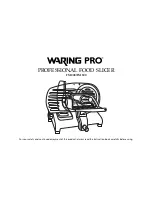
NUTS
To dry nuts, first shell and rinse them with warm
water. Pat dry and spread out on trays. Most
nuts will take approximately 20 to 30 hours
to dehydrate and they should be allowed to
dehydrate until brittle.
Allow them to cool after dehydrating. Any nuts
that will not be consumed within a few days
should be frozen to ensure freshness. Allow them
to defrost before eating.
HERBS AND FLOWERS
To dry herbs and flowers, first rinse and pat
dry. Remove any dead, mushy or discoloured
portions, leaving the stem intact. Spread herbs or
flowers on tray and allow to dehydrate for about
2 to 7 hours, depending on their type and size.
Remove from tray and allow to cool when drying
is complete. Remove the leaves or buds from
stem and break them apart. Crush if desired.
For best results, pick flowers after the rising sun
evaporates the morning dew and before the cool
evening mist settles on the petals. Be aware of
flowers that have been sprayed with insecticides
or other harmful chemicals; do not use these.
If you are dehydrating flowers at the same time
as herbs, place flowers on the bottom trays and
herbs on the top trays; this prevents any debris
from the flowers falling on the herbs.
USEFUL TIPS
•
Wash and clean the dehydrator before
using if it has been stored for a long time.
•
Fresh vegetables and fruits are best
for dehydrating; canned goods do not
dehydrate well.
•
All vegetables and fruits should be
cleaned before preparation and
pretreatment.
•
Prepare and pretreat fruits and vegetables
as outlined in this manual for best results.
•
It is usually not dangerous to leave the
dehydrator on for a long period of time
when required, but make sure that it is
in a safe location. Read the Important
Safeguards section on page 2 of this
manual, and exercise caution when using
the dehydrator.
•
Exact dehydrating time can vary greatly,
depending on the type of food used, its
size and quality, the quantity placed on
trays and your personal preferences.
Keeping your own notes on the type of
food, weight before and after drying, total
drying time, and final results will enable
you to achieve the desired outcome, every
time!
•
Most recipes will work well with dried
foods. By experimenting with the recipes
offered in this manual, you’ll soon discover
your own unique ways of using dried
foods. You’ll also be able to find books on
the topic in bookstores, both locally and
online.
• For best results, it is recommended
to rotate the trays midway through the
dehydration process. For example, move
the bottom tray to the top, as items in the
bottom rack will dehydrate faster than
those on top.
FOOD STORAGE
Packaging
In order to keep well, dried foods must be
carefully packaged. Pack dried foods in plastic
freezer bags, squeezing out as much air as
possible. (You can also use heat-sealable bags.)
Store plastic bags inside airtight metal, plastic or
glass containers. When you store foods in rigid
containers without putting them into freezer bags
first, you expose the dried foods to air, which will
negatively impact them. Vacuum packaging will
greatly extend the shelf life of your dried foods –
vacuum packaging equipment for home use can
be found in some stores.
Storage Conditions
Store appropriately packaged dried foods in a
cool, dark place. The colder the food is kept, the
longer the quality will be maintained. For every
8˚C drop in temperature, the shelf life increases
2 to 3 times, so if you have room in a refrigerator
or freezer, keep your dried foods there. If not,
find the coolest place in your home to store dried
foods. Light also causes the quality and nutritive
value to deteriorate, so keep dried foods in
opaque or dark-coloured containers.
8


































